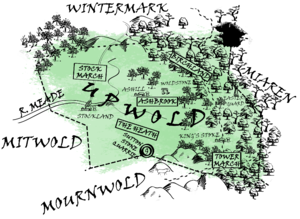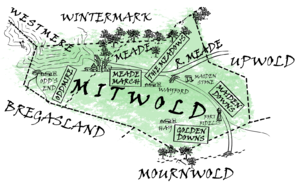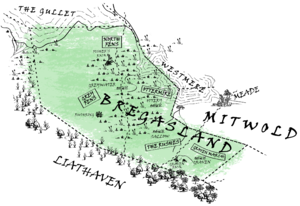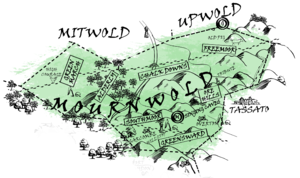The Marches territories
No edit summary |
|||
| Line 14: | Line 14: | ||
==[[Bregasland]] the Dour Fens== | ==[[Bregasland]] the Dour Fens== | ||
Sandwiched between the dark woods of [[Liathaven]], the southern [[Jotun]] kingdoms, and the sea, lies Bregasland. The territory is primarily made up of freshwater fenland. Home to “Bregas” (fenlanders), this is a place of small islands of abundantly fertile soil, surrounded by seemingly endless marshes where eels are caught. There are several households here made up entirely of [[merrow]], and several settlements populated by people who have been shunned but cannot bring themselves to leave the Marches. | '''Lost in 384YE''' Sandwiched between the dark woods of [[Liathaven]], the southern [[Jotun]] kingdoms, and the sea, lies Bregasland. The territory is primarily made up of freshwater fenland. Home to “Bregas” (fenlanders), this is a place of small islands of abundantly fertile soil, surrounded by seemingly endless marshes where eels are caught. There are several households here made up entirely of [[merrow]], and several settlements populated by people who have been shunned but cannot bring themselves to leave the Marches. | ||
Bregasland is home to partially sunken ruins, including several stone circles that pre-date Marcher possession of the land. It is also home to dangerous man-eating lizards, giant insects, flesh-eating plants, [[marshwalkers|marshwalkers]], bottomless bogs and strange lights that seek to lure the incautious into deadly situations. Those who explore the depths of the marshes here sometimes disappear without trace ... | Bregasland is home to partially sunken ruins, including several stone circles that pre-date Marcher possession of the land. It is also home to dangerous man-eating lizards, giant insects, flesh-eating plants, [[marshwalkers|marshwalkers]], bottomless bogs and strange lights that seek to lure the incautious into deadly situations. Those who explore the depths of the marshes here sometimes disappear without trace ... | ||
Revision as of 20:07, 23 March 2023
Overview
The Marches lie in the western Empire. Mitwold and Upwold are largely made up of fertile farmland, while Bregasland is rich fenland and the Mournwold is a combination of wide grasslands and rolling hills. The territories are covered in a patchwork of farms, small villages, household estates, and the occasional small town. While much of the Marches is civilised, there are still plenty of wild lands - deep forests, lonely hills, and dour marshes alike can harbour greedy brigands, savage orcs, lost ruins, and hungry monsters.
Upwold, The Silver Chase
Upwold is where the Marchers first established themselves when they walked away from Dawn. The scattered orc nations that dwelt here were no match for the Marcher determination to carve out a home for themselves and were swiftly driven out or defeated. Today, Upwold is a wealthy territory in a wealthy nation, although perhaps surprisingly a significant amount of its wealth comes from industries other than farming. While there are of course many farms in Upwold, the eastern forests of quick-growing silver birch trees provide a great deal of income. Charcoal-burners live there, turning wood into easily transportable fuel for smith and hearth alike while the birch bark is used in the tanning industry, to cure the hides of the cattle that graze on the river pastures.
The forests of Upwold also create a need for skilled beaters - the woodlands are deep and the Feni that make their homes there do not welcome trespassers. For the most part, the painted savages keep to themselves but every few years there is an incidence of raiding, or an attack on a lumber camp or charcoal burner village that they decide has strayed too far into "their" woods.
Mitwold, Pride of the Marches
More than in Upwold or Bregasland, the households of Mitwold engage in feuding and bitter rivalry. The closer two households are to one another in Mitwold, the more likely it is that they are engaged in a long-running feud. This is also the territory where many of the best known ball games are played, and it is a regular occurrence for some dispute to be settled by a savage game of rugby, football or rounders. Outside observers wryly observe that this enthusiasm for sports arises directly from the simmering resentment between the houses - or as often as not is part of the cause.
Mitwold's substantial coast, populated by small fishing villages along the shore, gives way to fertile chalk-soiled downs further inland, with rich game-filled woodland and larger farms and market towns beyond. The city of Meade stands on the western coast of Mitwold - the largest settlement in the Marches, and in some ways its spiritual heart.
Bregasland the Dour Fens
Lost in 384YE Sandwiched between the dark woods of Liathaven, the southern Jotun kingdoms, and the sea, lies Bregasland. The territory is primarily made up of freshwater fenland. Home to “Bregas” (fenlanders), this is a place of small islands of abundantly fertile soil, surrounded by seemingly endless marshes where eels are caught. There are several households here made up entirely of merrow, and several settlements populated by people who have been shunned but cannot bring themselves to leave the Marches.
Bregasland is home to partially sunken ruins, including several stone circles that pre-date Marcher possession of the land. It is also home to dangerous man-eating lizards, giant insects, flesh-eating plants, marshwalkers, bottomless bogs and strange lights that seek to lure the incautious into deadly situations. Those who explore the depths of the marshes here sometimes disappear without trace ...
Mournwold, the Mourn
Lost in 349YE, liberated in 381YE This desolate land was known as the Mourn even before its final fall to the Jotun hordes. Originally the name referred to the sound of the wind in the trees and across the craggy hills. After three decades of loss and bitterness, it seems an even more fitting name than ever for this lonely land of chalky sheep-grazed grassland and dark-boned hills.
Whereas Upwold and Mitwold in particular are known for their sprawling farms, the rugged terrain of the Mourn is better known for its mines. The folk of the Mourn have a reputation for holding grudges, and for being stubborn and quarrelsome, even among their fellow Marchers. Prior to the invasion of the Jotun, there had been a growing tide of dissatisfaction among professional miners that all political power had been vested in the hands of those who owned farms. The Jotun invasion more -or-less put an end to this grumbling, but events during the occupation and ultimate liberation of the territory have proved even more incendiary for the people of the Mourn, the Marches, and the Empire.
Marcher Territories in Play
Every character in Empire has a home territory - which is the territory where your personal resource is located. Land is especially important for Marchers - their society is based around farming and ownership of farms. The territory where they live effects who you can vote for during Senator elections, but in the Marches who you are is sometimes seen as a function of where you are from.
If you are part of a Marcher household, market town, or monastery, you probably all want to be from the same territory - if you make a mistake during character creation an e-mail can easily sort that out. After you start playing your character, however, changing your home territory is a little more complicated - it costs money, and if you have upgraded your personal resource you may lose out - so ideally you want to get your territory right before the game begins.
You don't need to declare which region you live in, but given how Marchers feel about where you come from its usually a good idea to look over the territory page and pick a region. You might be from one of the established settlements, or you might have your own village or farm anywhere in the territory - the named villages and towns are by no means the only settlements in the Marches! Your character background, or your group background, can include a few details about your home if you like.
Each of the four territories has certain themes, which are often used as a starting point when plot writers create plot. Furthermore, certain personal resources lend themselves to certain territories better than others.
Being from Bregasland
The marshy territory of Bregasland has a theme of strangeness. The pub from American Werewolf in London with its suspicious villagers and grim secrets might be an example of a Bregasland settlement, as might the weird town of Innsmouth from Lovecraft's fiction (albeit with less emphasis on tentacled horrors). The stereotypical Bregas is insular and suspicious. This is also a territory with several mysteries - the dead waters, the strange rocks, the odd ruins, the rum beasts - which while they may not get explored in play can provide an interesting underpinning to your character's background.
Outside of Gravenmarch most of the territory is marsh - farm life is very different in Bregasland than in the rest of the Marches - you're more likely to be raising eels than sheep. Bregasland is an excellent choice however if you play to have a herb garden, and its emphasis on strange mysteries makes it a good choice for a mana site. Along with Mitwold, Bregasland also has a coastline. While it lacks the emphasis on foreign trade that its richer neighbour enjoys, a character from Ottermire or North Fens could easily operate a fleet resource.
Incidentally, Bregasland is also an excellent territory to choose if you plan to play a character with the merrow lineage - the stereotypical Marcher merrow is often assumed to come from the Fens.
Being from Mitwold
The Pride of the Marches is rich, but it's theme is politics. The households, villages, towns, and monasteries of Mitwold are mostly locked in centuries long feuds. The citizens of one village view their neighbours in the next town as everything that is wrong with the Marches. They scheme and plot against each other, and to advance their own household. The stereotypical Mitwolder thinks their home is the best part of the Marches - and would rather deal with someone from another nation or even another country than someone from another part of Mitwold.
This is a good territory to establish a group, and is an excellent choice for a yeoman's farm, alderman's business,or a monk or friar's congregation. It's also a good choice for a military unit - local militias like the Hay irregulars and the yeomen soldiers associated with a household are both good examples of military units. Mitwold is also one of the best places in the Marches to have a fleet resource - the city of Meade and the town of Odd's End both have strong traditions of trading with foreign powers.
Being from the Mournwold
The Mourn has only recently been liberated after thirty years of Jotun occupation. The theme here is conflict - even before the Jotun came the Mournwold was uneasy. The conflict between the mine workers and the farm owners, for example, had been simmering for generations and was very close to boiling over. When the Empire came to liberate the Mourn, their actions soured the people against them and even if solutions are found it is likely many Mournwolders will continue to resent Imperial citizens for decades to come.
If the Mourn is your home territory, you have an obvious first question to answer - did you stay, or did you go? When the orcs conquered the Mournwold, many families chose to stay on their land, and lived as thralls of the Jotun warlords. The orcs were not especially cruel, but they were harsh masters, taxing their thralls mercilessly to support their war effort. You are likely to have some understanding of the Jotun (it is well worth looking over the Jotun page for background details). In particular, access to weaponry and armour was restricted - thralls are by definition not allowed to fight. Likewise, you will have grown up or spend three decades alongside orcs - both warrior-orc overlords and orc thrall neighbours. How has this shaped your attitude to orcs - what will you make of the Imperial Orcs? Did you support the resistance? How do you feel about the exiles returning to the Mournwold now it has been liberated? How do you feel about the Empire's actions leading up to the liberation - remember that roughly one in six people living in the Mournwold died at the hands of the Military Council's powerful curses.
On the other hand, many yeomen fled north and lived in exile in the remaining Marcher territories. If you or your family fled, and returned after the Mournwold was liberated, you may encounter prejudice from those who stayed behind - or view those who stayed as collaborators. How easy was it for you to reclaim your family land? What do you make of the orc thralls scattered across the Mournwold?
The Mournwold is an excellent choice of home territory for anyone who wants to have a mine resource - before the Jotun came it was the centre of Marcher mining. Yet having a mine in Mournwold brings with it a little baggage - the relations between mine owners and farmers is not an easy one. It's also a good choice for a farm, obviously - although it is probably a slightly less appropriate choice for a business unless your resource either represents something the orcs would have made use of (a forge perhaps), or a new establishment in the wake of the liberation. It's also an interesting choice for a forest or herb garden especially if you are planning to play one of the residents of the forest of Alderly.
Being from Upwold
The Silver Chase is the oldest of the Marcher territories, and it is steeped in history and tradition. It's where the exodus from Dawn ended, and where they built their first farms - and had their first fights with the native orcs. In their hearts, many Upwolders know they are the only true Marchers - and some resent that the people of Mitwold have largely eclipsed them in terms of wealth and influence. There are elements of Upwold that reflect elements of the other three territories - understandable given that at the end of the day almost everyone is descended from people who first settled in Upwold. Like Bregasland, it has it's own strangeness - the Woldstone and the village of Mumford. Like Mitwold it has its feuds and factions - it's easy to imagine the people of Stockland feuding with the folk of King's Stoke over politics, Like Mournwold, it has it's unique industry - the woodlands of Birchland and Tower March are the best places in the Marches to have a forest resource, for example (although a business could also represent a lumberjack, charcoal burner, or forest warden just as easily).
Upwold is a great choice for a farm or business, but it also makes a good choice for a congregation perhaps as part of a monastery focusing on preserving the Marcher's odd religious traditions. As with Mitwold, it is a good place for a military unit - there is a long tradition of Upwold protecting the rest of the Marches from Dawn and Wintermark, and while these days the three nations are technically allies, tradition dies slowly in the Marches. Today, Upwold soldiers are more likely to be concerned with bandits, feni, the weird creatures lurking in the depths of the Bloody Great Hole, or have spent the last three decades watching the borders with Mournwold.
Further Reading
Core Brief
Additional Information



